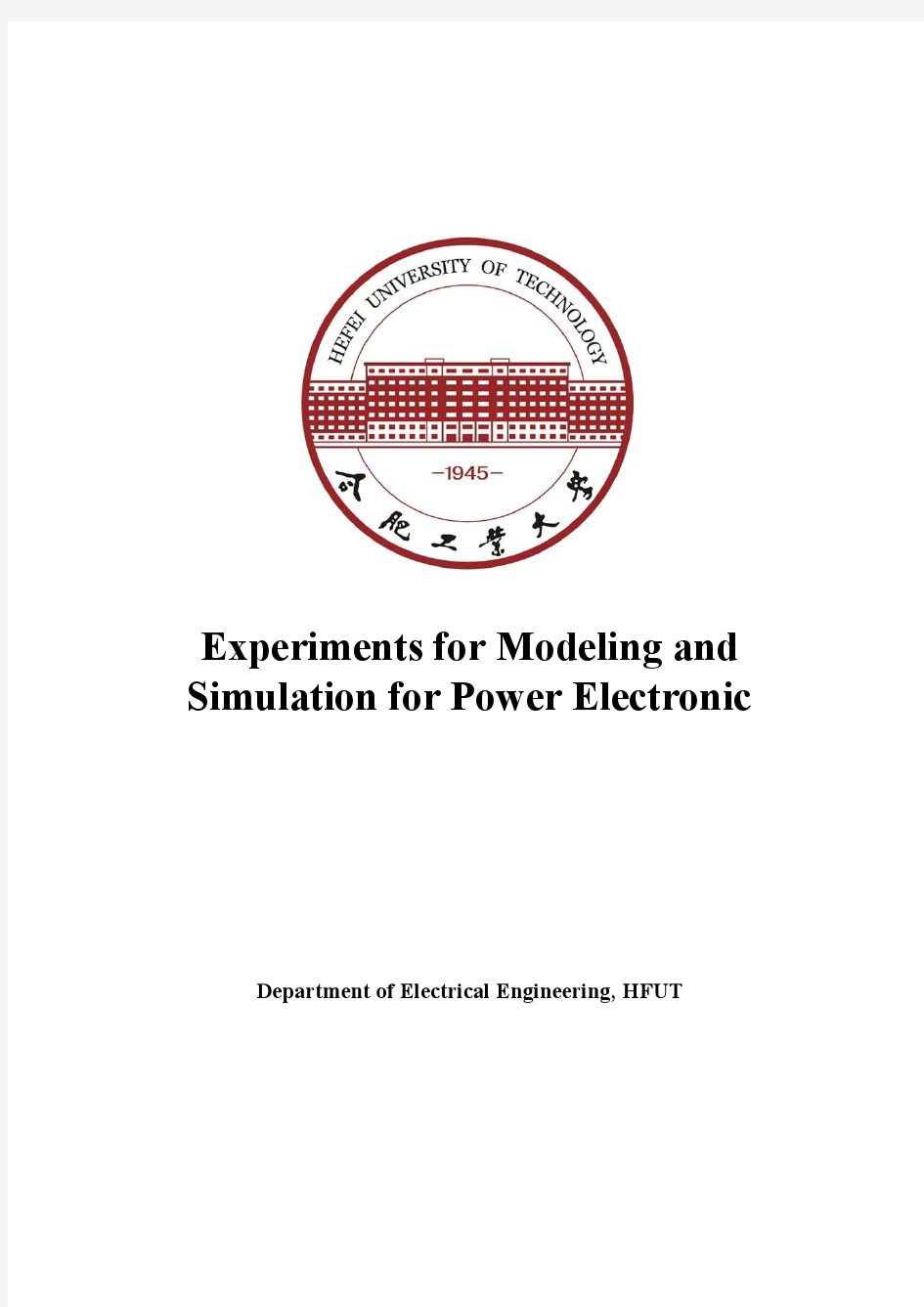电力电子建模与Pspice仿真_4

相关主题
- 1、下载文档前请自行甄别文档内容的完整性,平台不提供额外的编辑、内容补充、找答案等附加服务。
- 2、"仅部分预览"的文档,不可在线预览部分如存在完整性等问题,可反馈申请退款(可完整预览的文档不适用该条件!)。
- 3、如文档侵犯您的权益,请联系客服反馈,我们会尽快为您处理(人工客服工作时间:9:00-18:30)。
Figure 1-5 ripple component in the output voltage
4. Obtain io1 by means of Fourier analysis of the io waveform. Compare io1 with its precalculated nominal value. Solution Applying Fourier analysis, we obtain i01 as following
400V
0V
-400V V(L1:1)- V(V5:-) 20A
0A
SEL>> -20A 0s - I(V1)
2ms
4ms
6ms
8ms
10ms
12ms
14ms Time
16ms
18ms
20ms
22ms
24ms
26ms
28ms
30ms
Figure 1-3 waveforms of v0 and id
Figure 1-6 ripple component in the output current
6. Obtain
I d (avg )
and
id 2
(the component at the 2nd harmonic frequency) by
means of the Fourier analysis of the id waveform. Compare them with their pre-calculated nominal values. Solution Applying Fourier analysis, we obtain the following values.
16A
12A
8A
4A
0A 0s -I(V1) Time 1ms 2ms 3ms 4ms 5ms 6ms 7ms 8ms 9ms 10ms 11ms 12ms 13ms 14ms 15ms
Figure 2-5 waveform of id
2. Obtain vAn1 by means of Fourier analysis of the v An waveform. Compare vAn1 with its pre-calculated nominal value. Solution Applying Fourier analysis, we can obtain vAn1 .
1. Obtain the following waveforms using 1Phbsinv: (a) vo and io . (b) vo and id . (c) vo , io and po . Solution
400V
We obtain the following waveforms shown in Fig.1-2, 1-3 and 1-4.
Experiments for Modeling and Simulation for Power Electronic
Department of Electrical Engineering, HFUT
Part One: 1-phase,bipolar-voltage-switching Inverter
May 30th, 2012
Introduction
The schematic of the circuit is shown in Fig.1-1.
Figure 1-1 schematics of the bipolar-voltage-switching inverter
Solutions to problems
400V
200V
0V
-200V
-400V 0s 5ms V(L1:1)- V(V5:-) 10ms 15ms 20ms 25ms Time 30ms 35ms 40ms 45ms 50ms
Figure 2-4 waveform of vAn
(c)We obtain the following waveforms shown in Fig.2-5.
Figure 2-2 waveform of vAN
20A
10A
0A
-10A
-20A 0s I(L1) Time 5ms 10ms 15ms 20ms 25ms 30ms 35ms 40ms 45ms 50ms
Figure 2-3 waveform of iA
(b)We obtain the following waveforms shown in Fig.2-4.
where U0=153.33V, I0=10A, Ud=271V, cos =0.866. We can find out the two pairs of values are almost equal. 7. Using the results of Problem 6, obtain the high frequency ripple component id , ripple in the input dc current. Calculate its rms value. Solution The rms value of the high frequency ripple component in the input dc current would be
(1 THD 2 ) I 12 Id , ripple 3.96 A 2
where I1= 0.4692A,THD= 11.88.
Part Two: Three-Phase PWM Inverter
May 30th, 2012
Introduction
The schematic of the circuit is shown in Fig.2-1.
400V
We obtain the following waveforms shown in Fig.2-2 and 2-3.
200V
0V
-200V 0s V(L1:1) Time 2ms 4ms 6ms 8ms 10ms 12ms 14ms 16ms 18ms 20ms 22ms 24ms 25ms
vripple v0 v01
500V
0V
-500V 0s 2ms 4ms 6ms 8ms V(L1:1)- V(V5:-)-152.1694*sin(40*Time+72.4) 10ms 12ms 14ms Time 16ms 18ms 20ms 22ms 24ms 26ms 28ms 30ms
Figure 2-1 schematic of three-phase PWM inverter
Solutions to problems
1. Obtain the following waveforms using : (a) v An and i A . (b) van and i A . (c) v AN and id . Solution
i 01 9.5742sin(40t 13.54o ) A
iripple
in the output
The ripple component can be expressed as
iripple i 0 i 01
20A
10A
0A
-10A
-20A 0s 2ms 4ms 6ms 8ms I(L1)-9.5742*sin(2*pi*40*Time+13.54/180*pi) 10ms 12ms 14ms Time 16ms 18ms 20ms 22ms 24ms 26ms 28ms 30ms
5.0KW
0W
-5.0KW 0s 2ms 4ms (V(L1:1)-V(V5:-))* I(L1) 6ms 8ms 10ms 12ms 14ms Time 16ms 18ms 20ms 22ms 24ms 26ms 28ms 30ms
Figure 1-4 waveform of p0
2. Obtain v01 by means of Fourier analysis of the vo waveform. Compare vo1 with its precalculated nominal value. Solution Applying Fourier analysis, we obtain v01 of v0 waveform as following.
vripple vAn vAn1
The ripple waveform is shown in Fig.2-6.
400V
200V
0V
-200V
-400V 0s 5ms 10ms 15ms V(L1:1)- V(V5:-)-149.1*sin(2*pi*47.619*Time+137.2/180*pi) 20ms 25ms Time 30ms 35ms 40ms 45ms 50ms
i 01 13.54 / 2 9.5742 A
The pre-calculated nominal value of i0 is 10A. We can find out the two values are almost equal. 5. Using the results of Problem 4, obtain the ripple component current. Solution of i0 is According to the result of Problem 4, we know the fundamental harmonic
I d (avg ) 4.89 A
id 2 5.423 / 2 3.8346 A
Their nominal values’ expressions are U 0I 0 ( Id )average cos 4.8998 A Ud
Id 2 U 0I 0 4.0008 A 2Ud
v01 215.2 / 2 152.1694V
The pre-calculated nominal value of v0 is 153.33V. We can find out the two values are almost equal. 3. Using the results of Problem 2, obtain the ripple component the output voltage. Solution of v0 is
vAn1 149.1/ 2 105.4296 A
Its pre-calculated nominal value is 105.39V. We can find out the two values are almost equal. 3. Using the results of Problem 2, obtain the ripple component the output voltage. Solution of v0 is
wk.baidu.com
vripple
waveform in
According to the result of Problem 2, we know the fundamental harmonic
vAn1 149.1sin(2 47.619t 137.2o )V
The ripple component can be expressed as
0V
SEL>> -400V V(L1:1)- V(V5:-) 20A
0A
-20A 0s I(L1) Time 2ms 4ms 6ms 8ms 10ms 12ms 14ms 16ms 18ms 20ms 22ms 24ms 26ms 28ms 30ms
Figure 1-2 waveforms of v0 and i0
vripple
waveform in
According to the result of Problem 2, we know the fundamental harmonic
v01 152.1694sin(2 40t 72.4o )V
The ripple component can be expressed as
Figure 2-6 ripple component in the output voltage
